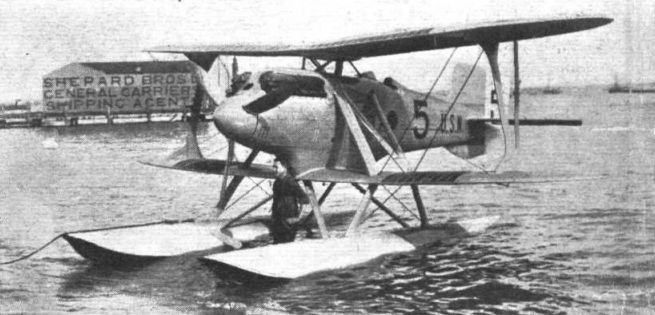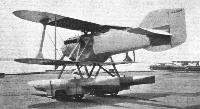
Flight, August 1923
THE AMERICAN NAVY-WRIGHT SCHNEIDER CUP CHALLENGER
IN our issue of FLIGHT for September 13 we gave an illustration of the Navy-Wright seaplane, one of the American entries for the Schneider Cup Seaplane Race. We have now received some particulars of this machine, which we give herewith, together with another illustration. From the latter a much better idea of the general design - strutting, etc. - may be obtained.
The N.W.-2, as it is called, is a biplane, powered with a 700 h.p. Wright T type engine, and is said to be the highest powered seaplane in the world. This 'plane will be piloted by Lieut. A. W. Gorton, U.S.N., and because of its airworthiness and seaworthiness will, it is believed, make an excellent record for itself in this event. On her trial trip the N.W.-2 exceeded the existing world seaplane record, averaging better than 180 miles per hour over a 2 1/2-mile course.
It has a wing spread of 28 ft., height 11 ft. 1 1/4 ins., and length 28 ft. 4 1/4 ins. The wing construction is cellular with ply-wood covering and wing radiator on the top and bottom side of the upper wing and top side of the lower wing.
The oil is covered by a water-cooler, arranged so that when the engine is first started and the oil cold, the oil temperature regulator transmits heat from the cooling water through a tube to the oil, and when the oil is up to proper temperature the flow of heat reverses and the oil temperature regulators act as a cooler and cool the lubricating oil.
The fuselage is of welded tubular steel throughout, and the tail surfaces are also of steel frame work. Very deep corrugations are used to give the maximum amount of cooling surface per square inch of wing area without detracting in any way from the speed characteristics and the lift of the wing.
The special racing propeller which will be used in the race is the culmination of long-continued experiments on model propellers in America. It is a three-bladed propeller, the blade being forged duraluminum, locked by a screw and wedge adjustment to a forged steel propeller hub. In order to give maximum clearance from the water a three-bladed propeller was decided on instead of the conventional one. The section of the propeller is such that no loss of efficiency results in the use of this smaller diameter section. It is of interest to note the extreme thinness of the propeller duraluminium blades when compared with the customary thickness of a wooden propeller of sufficient strength to absorb the tremendous horse-power generated by the Wright engine.
The N.W.-2 is supported with twin floats, which makes for more manoeuvrable and seaworthy characteristics than a single float with smaller ones at the end of each wing, and also aids in a fast landing on the water, regardless of whether it is rough or smooth, and amid varying wind conditions.
The vision is particularly good, being one of the most important fighting characteristics of this 'plane.
The craft is constructed with wing radiators built in sections, which are easily removable. The engine is built for heavy work, and shows a surprisingly light weight for the horsepower which it generates. It is a high compression, 700 h.p., 12-cylinder, V-type, water-cooled engine, weighing 1,150 lbs.
Another American entry is the T.R.-3A, equipped with a Wright E-4 engine, rated at 200 h.p., but which has pulled as high as 290 h.p. in the dynamometer room. The T.K-3A is a single-seater biplane, built for scouting purposes. Wing radiators have been installed in both upper and lower panels.
- Flight, August 1923
THE AMERICAN NAVY-WRIGHT SCHNEIDER CUP CHALLENGER
Фотографии
-
Flight 1923-09 / Flight
The ill-fated Navy-Wright, photographed at Cowes shortly before the flight that ended in a crash. The propeller is stated to have burst and punctured the floats, with the consequence that the machine crashed when the pilot attempted to alight.
-
Flight 1923-09 / Flight
Регистрационный номер: A-6544 [2] ANOTHER AMERICAN CHALLENGER: The Navy-Wright (N.W.-2) is to be piloted by Lieut. A. W. Gorton, U.S.N. The American machines have arrived, and are "stabled" at Saunders' of Cowes. The pilots will take every opportunity of getting in some flying practice, becoming familiar with the course, etc.
-
Flight 1923-09 / Flight
Регистрационный номер: A-6544 [2] The American Navy-Wright Schneider Cup Challenger: A three-quarter rear view of the machine "dry." From this view a good idea of the strutting arrangement may be obtained. Note the wing-radiators and shape of the wings.
-
Flight 1923-11 / Flight
The St. Louis International Air Meeting: Another view of one of the Navy Wrights, two of which finished third and fourth respectively in the Pulitzer Race.
-
Flight 1923-11 / Flight
A STUDY IN "FRONTS" FROM THE ST. LOUIS INTERNATIONAL AIR MEETING: The Navy Wright with a 700 h.p. Wright T.3 engine.
- Фотографии




